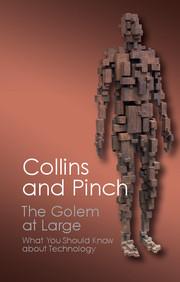Book contents
- Frontmatter
- Dedication
- Contents
- Preface and acknowledgements
- Introduction: the technological golem
- 1 A clean kill?: the role of Patriot in the Gulf War
- 2 The naked launch: assigning blame for the Challenger explosion
- 3 Crash!: nuclear fuel flasks and anti-misting kerosene on trial
- 4 The world according to Gold: disputes about the origins of oil
- 5 Tidings of comfort and joy: Seven Wise Men and the science of economics
- 6 The science of the lambs: Chernobyl and the Cumbrian sheepfarmers
- 7 ACTing UP: AIDS cures and lay expertise
- Conclusion: the golem goes to work
- References and further reading
- Index
Introduction: the technological golem
Published online by Cambridge University Press: 05 June 2014
- Frontmatter
- Dedication
- Contents
- Preface and acknowledgements
- Introduction: the technological golem
- 1 A clean kill?: the role of Patriot in the Gulf War
- 2 The naked launch: assigning blame for the Challenger explosion
- 3 Crash!: nuclear fuel flasks and anti-misting kerosene on trial
- 4 The world according to Gold: disputes about the origins of oil
- 5 Tidings of comfort and joy: Seven Wise Men and the science of economics
- 6 The science of the lambs: Chernobyl and the Cumbrian sheepfarmers
- 7 ACTing UP: AIDS cures and lay expertise
- Conclusion: the golem goes to work
- References and further reading
- Index
Summary
‘Science seems to be either all good or all bad. For some, science is a crusading knight beset by simple-minded mystics while more sinister figures wait to found a new fascism on the victory of ignorance. For others it is science which is the enemy; our gentle planet, our slowly and painfully nurtured sense of right and wrong, our feel for the poetic and the beautiful, are assailed by a technological bureaucracy – the antithesis of culture – controlled by capitalists with no concern but profit. For some, science gives us agricultural self-sufficiency, cures for the crippled, a global network of friends and acquaintances; for others it gives us weapons of war, a school teacher's fiery death as the space shuttle falls from grace, and the silent, deceiving, bone-poisoning, Chernobyl.
Both of these ideas of science are wrong and dangerous. The personality of science is neither that of a chivalrous knight nor pitiless juggernaut. What, then, is science? Science is a golem.
A golem is a creature of Jewish mythology. It is a humanoid made by man from clay and water, with incantations and spells. It is powerful. It grows a little more powerful every day. It will follow orders, do your work, and protect you from the ever threatening enemy. But it is clumsy and dangerous. Without control a golem may destroy its masters with its flailing vigour; it is a lumbering fool who knows neither his own strength nor the extent of his clumsiness and ignorance.
A golem, in the way we intend it, is not an evil creature but it is a little daft. Golem Science is not to be blamed for its mistakes; they are our mistakes. A golem cannot be blamed if it is doing its best. But we must not expect too much. A golem, powerful though it is, is the creature of our art and our craft.’
- Type
- Chapter
- Information
- The Golem at LargeWhat You Should Know about Technology, pp. 1 - 8Publisher: Cambridge University PressPrint publication year: 2014

